Napoleonic Europe
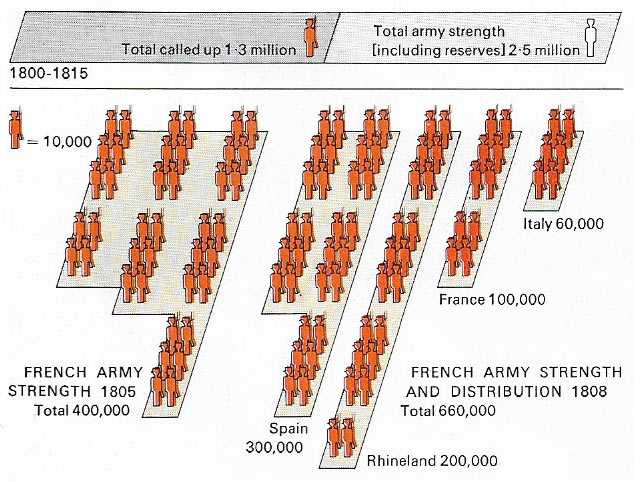
Figure 1. Conscription on an unprecedented scale laid the foundation for the armies that enabled Napoleon to dominate Europe. From 1800–1812, and average of 85,000 men were called up from France each year. The demand for military manpower grew increasingly onerous, especially in 1812 with the costly invasion of Russia. Total deaths during the Napoleonic wars were about one million, of which 400,000 were French.
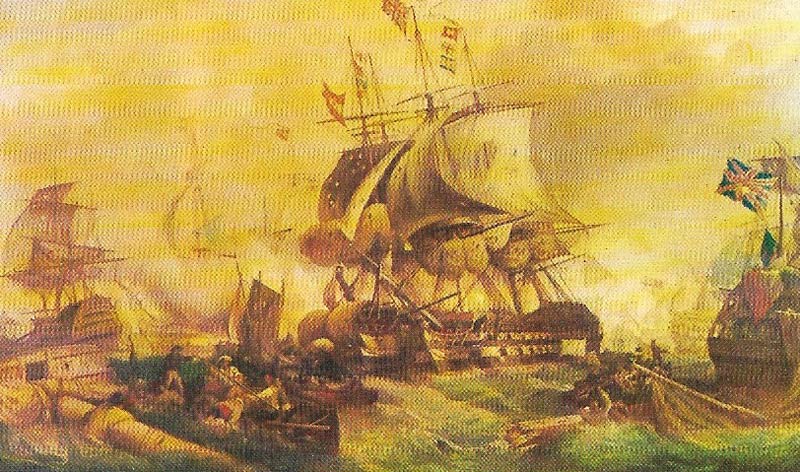
Figure 2. Nelson's annihilation of the combined French and Spanish fleets at Trafalgar was the decisive event in the long war and convinced Napoleon that direct assault on Britain was impossible. Saved from invasion, Britain used her superb navy to blockade the coasts of Europe and her wealth to organise resistance to France. Napoleon was forced to extend his control of neighboring states to stifle British trade and the hostility this caused finally brought down his empire.
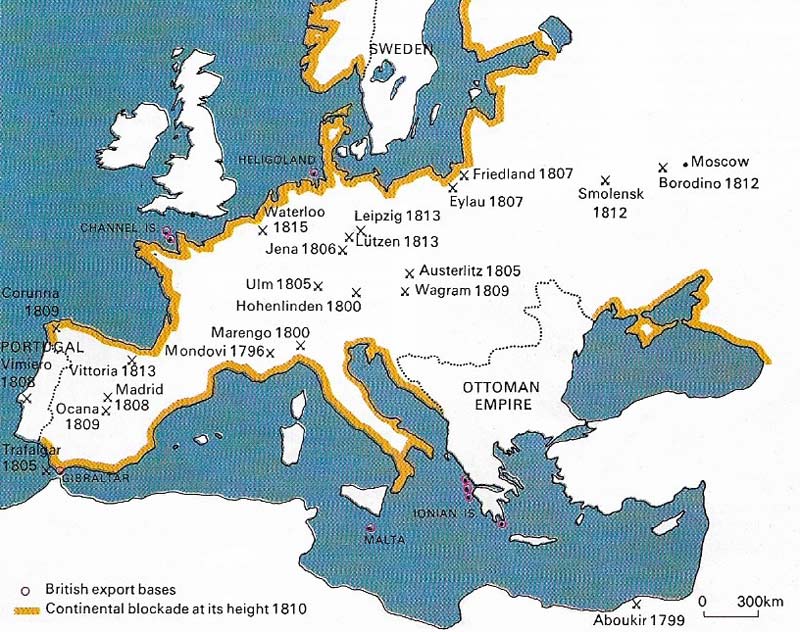
Figure 3. Brilliant victories in an almost continuous series of campaigns enabled Napoleon to establish France temporarily as the main power in Europe. In controlling the "traditional" powers of Austria, Prussia and Russia by a mixture of war and diplomacy, he enjoyed almost total success. But the need to extend and consolidate the Continental System led him to become trapped in a guerrilla war in Spain and then to launch the disastrous invasion of Russia.
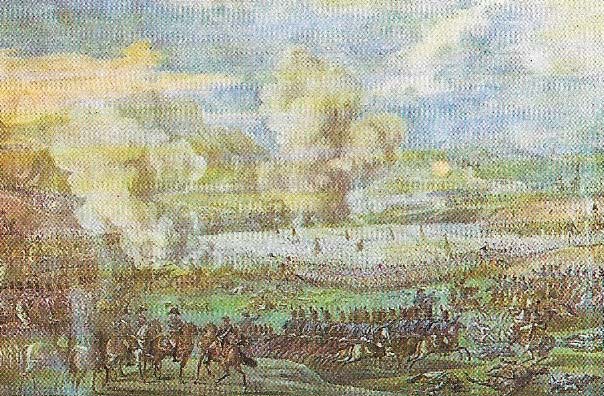
Figure 4. Napoleon's victory at Austerlitz and the campaign that preceded it showed all the qualities of speed and decisiveness that made him one of the greatest generals the world has seen. Having forced-marched the Grande Armee from the Channel to the Danube, he destroyed an Austrian army at Ulm and then pushed a Russian force back until it rejoined the main Russian army at Austerlitz. In the ensuing battle he used a combination of devastating artillery barrages and massive infantry assaults to sweep the Russians off the vital heights commanding the field of battle and into a precipitate retreat.
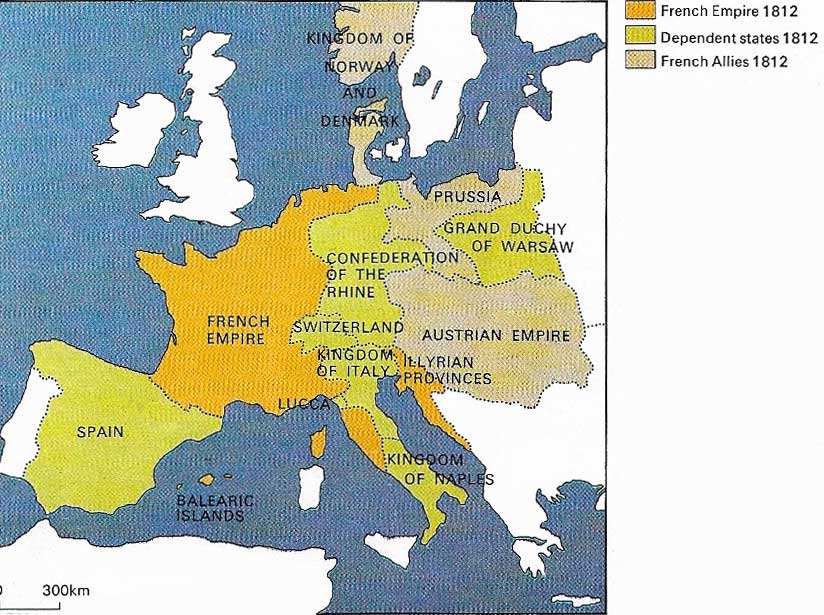
Figure 5. Almost all Europe in 1812 was either ruled directly by Napoleon or members of his family, or allied with him. At the outset Napoleon had been able to draw on widespread support in Europe for the revolutionary ideals of overthrowing the old order. He furthered his own power by using the desire of neighboring states for freedom, organizing many small states of Italy and Germany into dependent republics and setting up the Confederation of the Rhine that effectively ended the Austrian-dominated Holy Roman Empire.
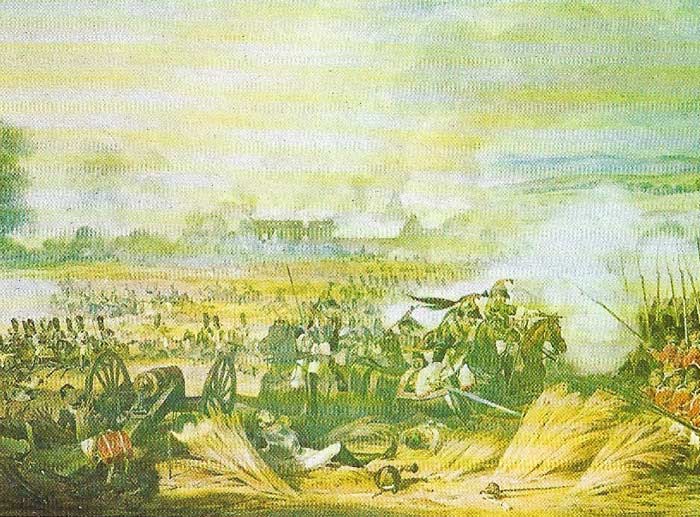
Figure 6. Napoleon was finally defeated at Waterloo, near Brussels. By British and Prussian troops led by the Duke of Wellington and Marshal Blucher. An alliance of major European powers and conquered states had previously forced Napoleon to abdicate, but he has viewed exile on Elba only as an interlude. When the restored Bourbons had earned the dislike of most Frenchmen and the allies were bickering among themselves at Vienna, he returned and marched to Paris with popular support. But the shock tactics of the Grande Armee met their match at Waterloo where British infantry held form against cavalry and infantry assaults until relieved by the Prussians.
In 1800, Napoleon Bonaparte (1769–1821) became first Consul of France, then still menaced by hostile states. His new constitution confirmed the conservative policies of the Directorate and concentrated internal authority in his own hands. Once in power, he acted swiftly to achieve peace in Europe. After a surprise crossing of the Alps, he shattered Austrian power in Italy at the Battle of Marengo on June 14, 1800 and made peace with her at the Treaty of Luneville. Russia, under the pro-French Tsar Paul (1754–1801), also ceased hostilities against Napoleon and in December joined Prussia, Denmark and Sweden in a French-inspired League of Armed Neutrality designed to weaken Napoleon's chief remaining foe, Britain, by blocking her trade with continental Europe.
 |
| Napoleon Bonaparte, the Corsican-born general who made himself Emperor of the French, had the military genius to win France a short-lived supremacy over most of Europe. But it was his reforms of French society in codifying the law and rationalizing education and administration that were his greatest achievements. Some of them endure to this day. |
War and peace
Although Paul was soon assassinated and succeeded by the pro-English Alexander (1777–1825), Britain made peace with France at the Treaty of Amiens in March 1802, agreeing to return all of her overseas conquests except Ceylon and Trinidad, while Napoleon agreed to evacuate Holland and Naples. However, Napoleon soon aroused British suspicions by looking for new colonies, by refusing to evacuate Holland, and by extending French power in Germany. When the British realized that French markets would still be closed to their goods, and that Napoleon was building up Antwerp as a commercial rival, they refused to evacuate Malta and war broke out again in May 1803.
During the years of comparative peace between 1800 and 1803, Napoleon began the internal reconstruction of France which was to be his most lasting achievement. The Bank of France was established in 1800 and tax collecting centralised; the law was remodelled and codified, and a centralised secondary school system was set up. Napoleon's concordat with the Papacy extended his power – the Catholic Church gave up its claims to nationalized Church property in return for state support. In 1802 Bonaparte became First Consul for life with the power to nominate his successor. The renewal of war identified Britain as Napoleon's most stubborn and dangerous enemy and at first he tried to defeat her by invasion. However the Royal Navy blockaded the coasts of France and Spain for more than two years and then under Vice-Admiral Horatio Nelson utterly destroyed the French and Spanish fleets at the Battle of Trafalgar on 21 October 1805 (Figure 2).
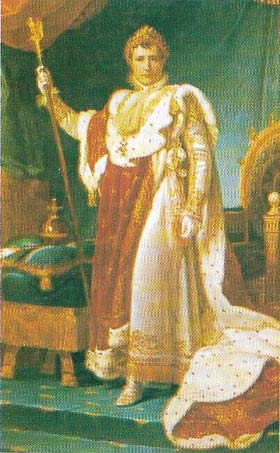 |
| As Emperor of the French, Napoleon used the trappings of imperial glory to consolidate his new dynasty. Most Frenchmen responded but some felt he had betrayed the egalitarian ideals of the Revolution |
Military and economic strategy
Even before this interim defeat of his invasion plan, Napoleon, who had declared himself emperor in 1804, had had to redeploy the Grande Armee to meet a renewed threat from Austria and Russia, who were now joined in a Third Coalition with Britain. In a swift campaign he smashed an Austrian army at Ulm on 20 October 1805, occupied Vienna and defeated the Russians at Austerlitz (Figure 4) On 26 December. At the Treaty of Pressburg with Austria, Napoleon gained complete control of Italy and unified much of Germany outside Prussia in the Confederation of the Rhine. Prussia felt obliged to intervene, but was defeated at Jena and Auerstadt in October 1806. Napoleon occupied Berlin and defeated the Russians at Friedland in June 1807. Meeting the tzar at Tilsit, he persuaded him to enter an alliance with France against Britain, which once again remained Napoleon's sole effective opponent.
Napoleon now sought to defeat Britain economically by using force to prevent her trade with any part of Europe. Despite the power which his victories had given him, the British continually found ways of smuggling in their goods, and Napoleon had to try to extend his "Continental System" ever farther afield. The military presence (1) and resulting economic hardships made Napoleon's rule increasingly unpopular with his subject nations.
In 1808 Napoleon forced Charles IV (1784–1819) Of Spain and his son Ferdinand to abdicate in favour of Napoleon's brother Joseph. The Spanish revolted and the British sent and army to support them. The Spanish campaign cost Napoleon more than 50,000 men and led to his first defeat on land. In 1810, Napoleon tightened up the Continental System by annexing Holland and the German coast. Europe was thrown into a commercial crisis that persuaded the tsar to end his alliance in December 1810.
Retreat from Moscow
In June 1812 Napoleon launched a massive invasion of Russia with 611,000 men. His troops reached Moscow, but lack of supplies and military reverses forced them into an undisciplined winter retreat, which left only some 10,000 men fit for combat. In February 1813 Prussia declared was on France and Austria, and many subject states followed. Napoleon was defeated at Leipzig in October and the Allies pushed into northern France while the British invaded across the Pyrenees. Paris was occupied on 30 March 1814; Napoleon abdicated on 11 April and was exiled to the island of Elba.
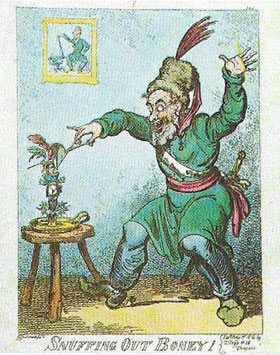 |
| The invasion of Russia was Napoleon's decisive error, celebrated by a Cruikshank cartoon. The Russians refused to make peace when Moscow was occupied and used scorched earth and guerrilla tactics to destroy the invasion armies and encourage subject states to rise. |
On 1 March 1815, Napoleon took advantage of quarrelling among the Allies and the unpopularity of the restored Bourbons in France to re-establish his power. But defeat by the Duke of Wellington (1769–1852) at Waterloo (Figure 6) on 18 June 1815 led to his exile on St Helena where he died in 1821.
